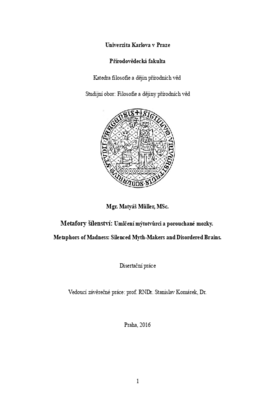Metafory šílenství: umlčení mýtotvůrci a porouchané mozky.
Metaphors of Madness: Silenced Myth-Makers and Disordered Brains.
dizertační práce (OBHÁJENO)

Zobrazit/
Trvalý odkaz
http://hdl.handle.net/20.500.11956/83737Identifikátory
SIS: 116982
Katalog UK: 990021165990106986
Kolekce
- Kvalifikační práce [21488]
Autor
Vedoucí práce
Oponent práce
Horáček, Ivan
Fulka, Josef
Fakulta / součást
Přírodovědecká fakulta
Obor
-
Katedra / ústav / klinika
Katedra filosofie a dějin přírodních věd
Datum obhajoby
30. 11. 2016
Nakladatel
Univerzita Karlova, Přírodovědecká fakultaJazyk
Čeština
Známka
Prospěl/a
Klíčová slova (česky)
anomálie psychiatrie paradigmatický posunKlíčová slova (anglicky)
anomalies psychiatry paradigm shiftPráce má v zásadě trojí cíl: 1. zmapovat širokou oblast různých přístupů v současné diskusi o šílenství, 2. předložit specifickou teorii šílenství, 3. identifikovat obecné filosofické problémy, před něž nás téma staví, (je naznačený i 4.: pochopit předloženou teorii jako základ pro určitý terapeutický přístup). Ústřední tezí práce je, že šílenství je bytostně mnohoznačný a neuchopitelný fenomén. K jeho pochopení užíváme různých metafor vypůjčených z jiných oblastí, přičemž následně zapomínáme, že se jedná o metafory. Práce je obecně vedena snahou usmířit různé přístupy, chápat je jako komplementární, zároveň se chce vyhnout na jedné straně pokusu o vytvoření všeobjímající syntéze, na druhé straně čistě relativistickému i pragmatickému hledisku. V první části práce identifikuji čtyři roviny, na kterých různé přístupy uchopují šílenství specifickým způsobem jako problém: rovinu individuální, kolektivní, transpersonální a existenciální. V závěru části uvažuji nad možnostmi a riziky vytvoření teoretického rámce, který by umožňoval různé vzájemně rozporuplné přístupy chápat na jednotném základu. Ve druhé části potom rozvíjím svůj vlastní přístup ke zkoumání šílenství. Zde vycházím z kombinace fenomenologické psychologie, analytické psychologie, ekopsychologie a na jejich základě pochopeného archaického...
The work has basically three aims: 1st to map the wide range of various approaches in the current debate about madness, 2nd to formulate a specific theory of madness, 3rd to identify general philosophical problems the topic brings about, (a 4th aim is also outlined: to understand the presented theory in terms of therapeutic potential). The central thesis of this work is that insanity is an inherently ambiguous and elusive phenomenon and that trying to understand it we are using various metaphors borrowed from other areas, and consequently forget their metaphorical nature. The work is generally motivated by an effort to reconcile conflicting approaches, to understand them as complementary. It also wants to avoid creating an all-embracing synthesis on the one hand, and purely relativistic and pragmatic viewpoint on the other hand. The first part identifies four levels on which particular approaches understand madness as a problem: the level of the individual, the level of the collective, the transpersonal level and the existential level. At the end of the part, I discuss the possibilities and risks of creating a theoretical framework that would enable to understand various contradictory approaches on a common basis. In the second part, I develop my own analysis of madness. It is based on a...
